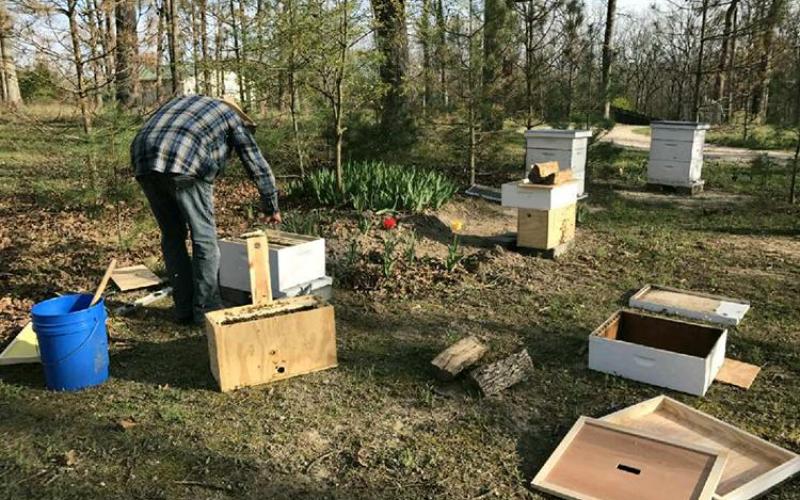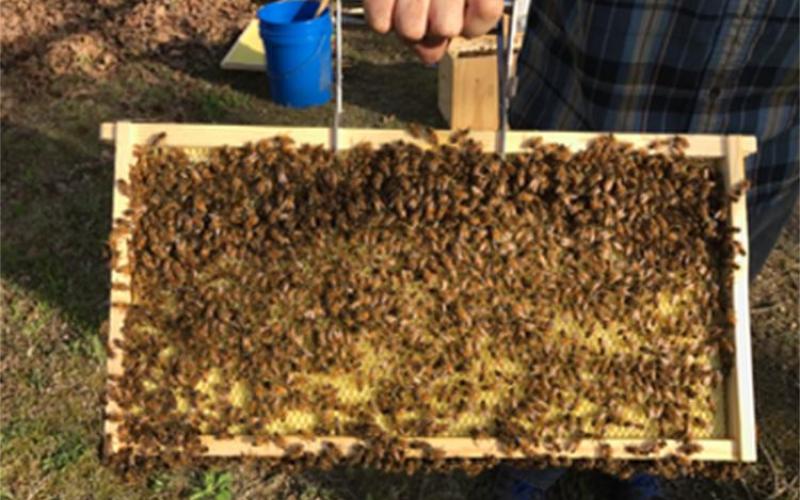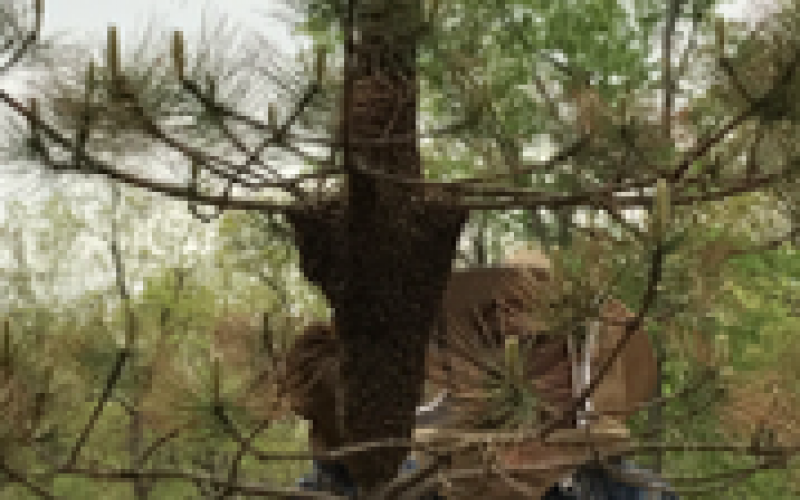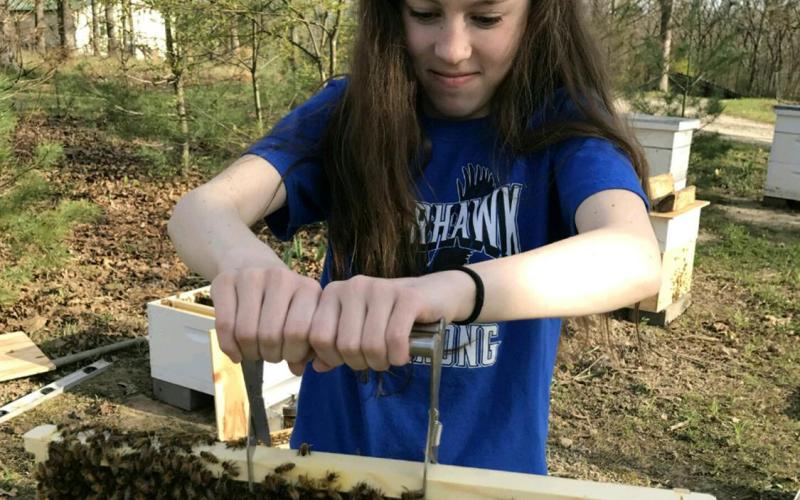Getting Down To BEESiness With The Joslin Family
By Emily Gargus
and Faith Skaggs
“On leaving the old nest, the swarm normally flies only a few metres and settles. Scout bees look for a suitable place to start the new colony. Eventually, one location wins favor and the whole swarm takes to the air.” -The Secret Life of Bees by Sue Monk Kidd.
Have you ever given much thought to how much bees actually contribute to human lives? Most people know that bees make honey and that honey is a delicious treat, but not many people realize how valuable it really is. Honey isn’t just used to sweeten delicacies such as granola, tea or graham crackers; it also serves many medical needs. The most important thing that bees do is pollinate. Pollination is needed for plants to reproduce, and so many plants depend on bees as pollinators.
According to the Department of Agriculture, Missouri is home to more than 400 different types of bees, including common species like the honey bee and carpenter bee, as well as lesser-known types like the blueberry bee. Missouri’s moderate climate is well suited to beekeeping.
The three of the most commonly encountered bees by homeowners are honey bees, carpenter bees and bumble bees. These bees usually become active in the spring with the warm weather and flowering of plants. They remain active throughout the summer and into the fall. Cooling temperatures in the fall prompt them to prepare to overwinter. During the winter months their activity decreases to the point where they are not seen unless on a warm winter day.
Missouri has over 25,000 beekeepers, and 34 beekeeping clubs. The Joslin family of Bourbon is one relatively new to this venture. In 2016, Jeremy and Melanie Joslin, and their children Garrett, Allyssa and Hunter, dove into the beekeeping world. Family friends of the Joslin’s were moving to a different state, and needed to find homes for their two hives. Jeremy and son Garrett, 18, decided it would be a beneficial endeavor for their family, purchased the hives for $300 and thus began their journey.
State agricultural experts say that many Missouri crops wouldn’t exist without bees. For example, one blueberry bee can visit as many as 50,000 flowers in it's lifespan of 3 months. These 50,000 visits result in the production of 6,000 blueberries. As another example, honeybees are extremely important pollinators in managed agricultural systems such as orchards. This goes to show that without bees, humans would have a very altered existence.
Garrett has taken a major role in establishing the family business. He also was able to use the beekeeping business as his SAE (supervised agricultural experience) project for FFA.
This project was essential in helping Garrett achieve the highest award at the state level, the state FFA degree. Garrett was one of four this year from Bourbon High School to receive this honor. Garrett was officially recognized for his achievements at the state FFA convention in April. This project helped Garrett learn even more about the bees themselves.
Honey bees are organized into three diverse categories which help the hive to thrive. The queen bee is the mother to all, her role is to mate and produce workers that essentially run the hive.
The workers consist of infertile females whose role it is to take on all labor tasks. The workers guard the hive, control the temperature of the hive, and prepare food to feed the queen, the drones, and the brood. The drones are the males in the hive. The drones only survive long enough to mate with a virgin queen and most don’t even receive that opportunity. When a queen leaves the hive, the rest of the bees must seek out a new maker. This is referred to as swarming. After this happens, the bees that swarmed away from the hive are in need of a new home, and this is when the role of the beekeepers comes to play.
Methods vary on how beekeepers move their bees after they swarm. Smoking the bees is a method that was developed centuries ago. It is used to calm the bees down when collecting honey, or when directing a swarm to a new box. Beekeepers still must take precaution when performing this method. The Joslin’s don’t use the smoking method when capturing the queen bee, but do when extracting the honey. However, the Joslin’s do wear headgear and gloves to safeguard themselves from bees’ apitoxin, or honey bee venom.
After all of the hard work the Joslin’s put into extracting the honey, they are prepared to begin processing and selling. Processing the honey is a rather simple process, according to Allyssa, 16. Processing mainly consists of the honey going through several different filters.
The honeycomb is removed from the hive and scraped into the initial filter using a hot knife utilized by electricity. The honey is then maneuvered through the different filters, spun through a turner, and is then discarded into a large bowl.
Finally, the honey is put into jars and is ready to be used for many practical needs.
Over the years, humans have come to learn about the numerous unexpected health benefits that honey has to offer. The Joslin’s have also taken advantage of this asset with their son Hunter, 14. When allergy seasons arises, Hunter takes a spoonful of honey one or two times a week. It has been scientifically proven that local honey can be a helpful remedy for allergies and other medical needs. With the Joslin’s number of hives growing, they have the opportunity to increase the supply of honey available in the area.
The Joslin’s two hives have now turned into seven because, according to Allyssa, the bees have been swarming quite a bit. Allyssa recounts one recent time when her dad had quite a task of getting to the queen bee to move her into a new hive. “My dad had to get a ladder to get to the highest part of the tree it would reach. From there he climbed on the branches to go higher. Once he got to the top, to the swarm, he found the queen bee and moved her to a trap. Surprisingly, the bees are pretty calm when you remove the queen. They just follow her to the new hive. We use the smoke to calm them when we go to get the honey, or if we have to do something with the hive. That is when the bees don’t like to be disturbed.”
From these hives, it is likely that they could harvest more than 100 pounds of honey from each hive every year. By the time the Joslin’s commence to selling their honey, it is probable that they may have even more hives considering every time the hive splits, a new hive is gained. Melanie, with help from Allyssa, has recently bottled the first 78 lbs of “Joslin’s Honey”.
As of right now, their honey has only been used to give out a few samples to friends and family. They plan to begin to sell it to the public by the end of the summer. Sweet success has definitely come for the Joslin family.




